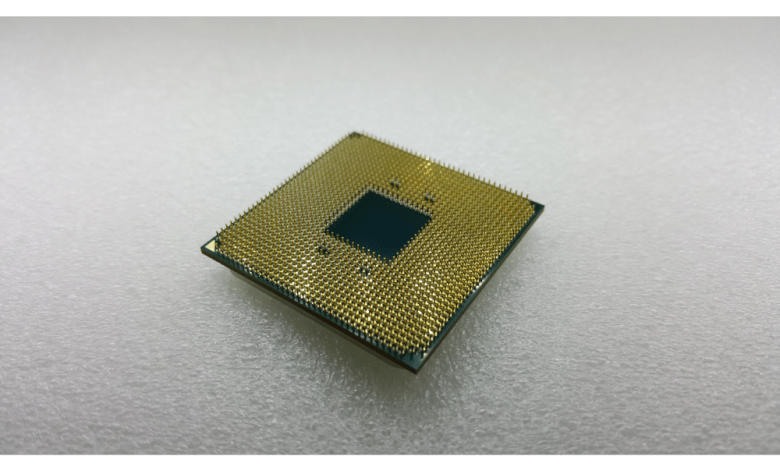Ryzen 5000 series of CPUs

Ryzen 5000 processors are a class leading range equally adept at work, play and creativity.
By BlueWater Tech
A landmark release by AMD
The Ryzen 5000 CPU family was released in October 2020. The Ryzen 5000 series brought the new 7nm Zen microarchitecture which upset existing benchmarks and calculations in the chip industry. With the potent 5000 series of processors, AMD flipped to the dominating position, over it’s rival Intel and effortlessly continues to occupy the top spot through 2022.
AMD revisited the basics of chiplet design to emerge with a groundbreaking 7nm chiplet microarchitecture that introduced gains that surprised everyone. To derive a broad sense as to how the 5000s have brought about a massive shift in the CPU landscape, we need to look at the remarkable, shrunken 7nm Zen 3 architecture.
Zen 3 design and architecture
The pathbreaking Zen 3 architecture has been achieved through a ground-up approach involving a revamp of the design and production basics that gave us the efficient Zen 2 chiplet. The earlier Gen Zen 2 processors powered earlier versions – Ryzen 3000s – which are very much in use and still offer meaningful benefits to gaming and work-related computing. Zen 3 with it’s singular feature set provides a quantum leap in processor capability and performance. It’s sizeable generational improvement helps it leap over it’s in-house predecessor as well as contemporary rival counterparts. A significant IPC uplift, speed boost, and energy efficiency are the chief gains of the 7nm process that give the Ryzen 5000s a lead in overall performance.
The outcomes of Zen 3 have impacted computing ability significantly. The gains are reflected in boosted efficiency and productivity gains in both single and multi-threaded applications productivity tasks as well as gaming.
Features of the Zen 3 powered Ryzen 5000s
- The Ryzen 5000 CPUs are constructed on the 7nm microarchitecture foundation which is the current benchmark for desktop CPU performance. The Zen 3 CPU design is the underpinning factor of the superior performance of the Ryzen 5000 series of CPUs. It enables the CPU to run on less energy, which, apart from providing energy savings also cranks up efficiency and speed owing to greater cooling.
- Ryzen 5000 CPUs are compatible with PCLe 4.0 across the board. Having PCLe 4.0 support means your SSD is capable of reading at 7 Gbps, which is double the rate of 3.5 Gbps at which PCLe 3.0 can read.
- Ryzen 5000 CPUs offer greater multi-core performance. Applications that require multiple core access, such as specific editing tasks, complex workstation tasks, and 3D animation are better served by these Ryzen CPUs as they have a comparatively larger head-to-head class-specific core count with hyperthreading.
- In keeping with the Ryzen tradition, the 5000 series of CPUs, owing to the brilliant Zen 3 chiplet microarchitecture delivers a 19 % improvement in IPC over it’s adversary. The higher IPC number offsets the seemingly lower CPU base frequencies. That translates into higher efficiency and speed in handling applications, whether they are academic, business, creative, or gaming.
- The Ryzen CPUs have a far more chunky L3 cache memory compared to the rival processors. The sizeable onboard cache allows brisk reading and transmission of frequently accessed data.
Here, are the outstanding Ryzen 5000s with their specifications and features that have assailed rivals and contemporary processors in their class,
The Ryzen 5000 line up – (Specifications)
Ryzen 5 – 5600X
Base speed : 3.7 Ghz | Boost speed : 4.6 Ghz | Architecture : Zen 3 | Cores : 6 | Threads : 12 | Socket : AM4 | TDP : 65W | Cache : Cooling system : Yes. Wraith Stealth | Cache : 32 MB |
Ryzen 7- 5800X
Base speed : 3.8 Ghz | Boost speed : 4.7 Ghz | Architecture : Zen 3 | Cores : 8 | Threads : 16 | Socket : AM4 | TDP : 105W | Cache : Cooling system : No | Cache : 32 MB |
Ryzen 9 – 5900 X
Base speed : 3.7 Ghz | Boost speed : 4.8 Ghz | Architecture : Zen 3 | Cores : 12 | Threads : 24 | Socket : AM4 | TDP : 105W | Cache : Cooling system : – No | Cache : 32 MB |
Ryzen 9 – 5950 X
Base speed : 3.4 Ghz | Boost speed : 4.9 Ghz | Architecture : Zen 3 | Cores : 16 | Threads : 32 | Socket : AM4 | TDP : 65W | Cache : Cooling system : No | Cache : 32 MB |
Gaming performance
The Ryzen 5600X with it’s bundled Wraith cooler, for instance, dominates over it’s rival series in the mainstream gaming area. The Ryzen 5600X excels to decidedly outperform it’s Intel counterpart – the i5 10600k ( overclocking notwithstanding) in the 1080p class and just noses ahead in 1440p gaming. Couple it’s class-leading performance with it’s price, and you get a fair idea of Ryzen’s overall superiority and impressive performance-to-price ratio. If, however, a Ryzen loyalist wants to address much heavier workloads, the Ryzen 7 5800X, with two additional cores, offers all that the 5600X does with an added and impressively large multi-threaded propensity.
The Ryzen 5000s derive their heritage superiority from the Zen microarchitecture. Only, it is the next level up from the Zen 2 design that graced the Ryzen 3000 series of CPUs. The Ryzen 5000 family is based on a vastly improved 7nm Zen 3 chiplet architecture which signals enormous gains in terms of IPC and L3 cache numbers. The Ryzen 5000 CPUs offer gains of up to 20 percent in IPC and have 8 cores accessing 32 MB of L3 cache resulting in overall swift operability. Boot times, downloads, and running applications are all quick, making accomplishing productivity tasks much faster.
5000s at work
It would be appropriate to mention here, that the 5000s are followed by a significant release which is named the 5000 G series of APUs. The 5000 G range of processors is built around the same 7nm process and Zen 3 architecture. The difference is that these come with built-in integrated graphics and so do not need an additional GPU. Another area of difference is the interface and frequencies. While the 5000s enjoy PCLe 4.0 lanes, the 5000 G series of APUs have the PCLe 3.0 interface. The focus of the 5000 G processors is obviously the areas of professional creativity and gaming.
Final thoughts
The Ryzen 5000 series of CPUs offer a well-rounded performance. It delivers both multi-core and single-core performance and is extremely adept at carrying out intense productivity tasks, complex editing, and crunching scientific data. In it’s class, it is a performance-leading option.
The 5000 G series of APUs are focused more on gaming and content creation and offer a perfect, powerful desktop CPU option.
For those of you who find that the Ryzen 5000 chips don’t offer enough power and performance, you could consider the blazing Ryzen Threadripper Pros, AMD’s most powerful personnel.





